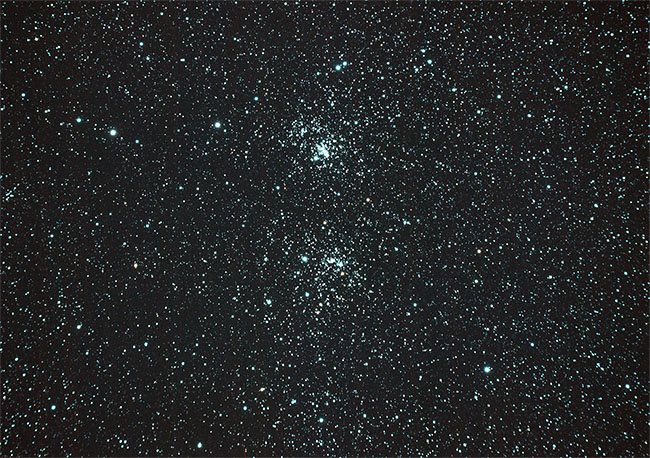Double cluster
 The double cluster is without any doubt one of my favorites visually. Photographically it is so-so. Click here to read more about this night.
The double cluster is without any doubt one of my favorites visually. Photographically it is so-so. Click here to read more about this night. 
 An open cluster is a group of up to a few thousand stars that were formed from the same giant molecular cloud and have roughly the same age. More than 1,100 open clusters have been discovered within the Milky Way Galaxy, and many more are thought to exist. They are loosely bound to each other by mutual gravitational attraction and become disrupted by close encounters with other clusters and clouds of gas as they orbit the galactic center, resulting in a migration to the main body of the galaxy as well as a loss of cluster members through internal close encounters. Open clusters generally survive for a few hundred million years. In contrast, the more massive globular clusters of stars exert a stronger gravitational attraction on their members, and can survive for many billions of years.
An open cluster is a group of up to a few thousand stars that were formed from the same giant molecular cloud and have roughly the same age. More than 1,100 open clusters have been discovered within the Milky Way Galaxy, and many more are thought to exist. They are loosely bound to each other by mutual gravitational attraction and become disrupted by close encounters with other clusters and clouds of gas as they orbit the galactic center, resulting in a migration to the main body of the galaxy as well as a loss of cluster members through internal close encounters. Open clusters generally survive for a few hundred million years. In contrast, the more massive globular clusters of stars exert a stronger gravitational attraction on their members, and can survive for many billions of years. ― source and more information wikipedia
― source and more information wikipedia
Date: 2013-11-30
Location: Haninge, Sweden
Temperature: -2 °C
Telescope: William-Optics Megrez 88FD
Camera: Canon 600D
ISO: 1600
Mount: Astrotrac mount and TW3100 wedge
Exposure time: 118 X 25 sec
Reducer/flattener: William-Optics 0.8X reducer/flattener (P-FLAT-F6)
Filter: Astronomik CLS
Other info: Used manfrotto 055 tripod.
Processing: Processed in Photoshop CS6.




 2013-11-30
2013-11-30 